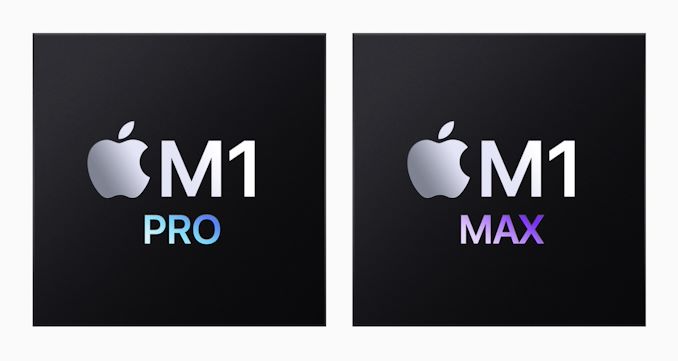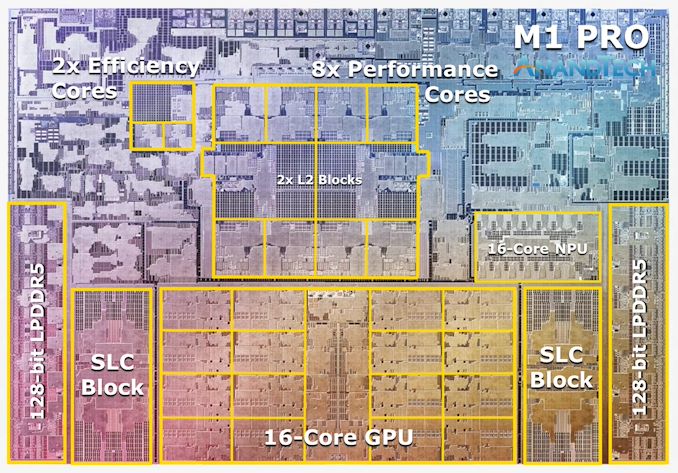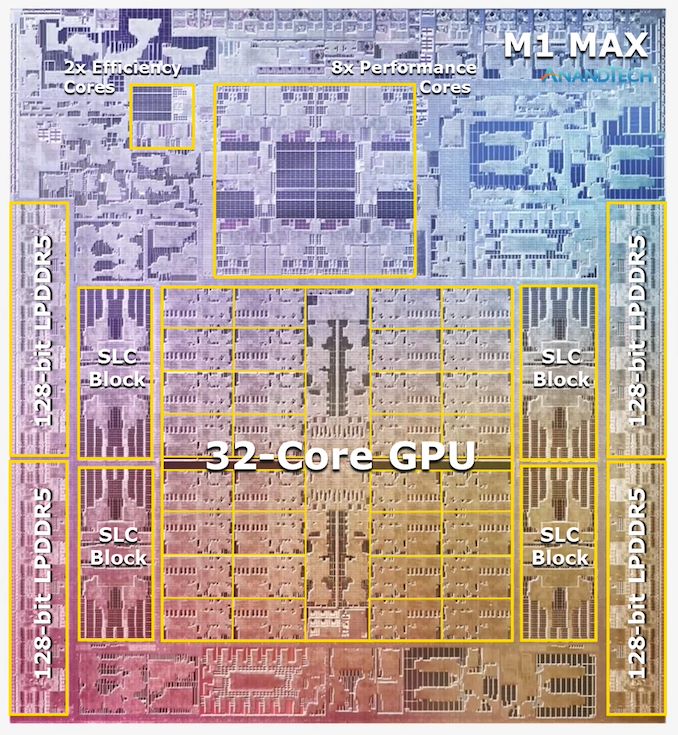Apple's M1 Pro, M1 Max SoCs Investigated: New Performance and Efficiency Heights
by Andrei Frumusanu on October 25, 2021 9:00 AM EST- Posted in
- Laptops
- Apple
- MacBook
- Apple M1 Pro
- Apple M1 Max

Last week, Apple had unveiled their new generation MacBook Pro laptop series, a new range of flagship devices that bring with them significant updates to the company’s professional and power-user oriented user-base. The new devices particularly differentiate themselves in that they’re now powered by two new additional entries in Apple’s own silicon line-up, the M1 Pro and the M1 Max. We’ve covered the initial reveal in last week’s overview article of the two new chips, and today we’re getting the first glimpses of the performance we’re expected to see off the new silicon.
The M1 Pro: 10-core CPU, 16-core GPU, 33.7bn Transistors
Starting off with the M1 Pro, the smaller sibling of the two, the design appears to be a new implementation of the first generation M1 chip, but this time designed from the ground up to scale up larger and to more performance. The M1 Pro in our view is the more interesting of the two designs, as it offers mostly everything that power users will deem generationally important in terms of upgrades.
At the heart of the SoC we find a new 10-core CPU setup, in a 8+2 configuration, with there being 8 performance Firestorm cores and 2 efficiency Icestorm cores. We had indicated in our initial coverage that it appears that Apple’s new M1 Pro and Max chips is using a similar, if not the same generation CPU IP as on the M1, rather than updating things to the newer generation cores that are being used in the A15. We seemingly can confirm this, as we’re seeing no apparent changes in the cores compared to what we’ve discovered on the M1 chips.
The CPU cores clock up to 3228MHz peak, however vary in frequency depending on how many cores are active within a cluster, clocking down to 3132 at 2, and 3036 MHz at 3 and 4 cores active. I say “per cluster”, because the 8 performance cores in the M1 Pro and M1 Max are indeed consisting of two 4-core clusters, both with their own 12MB L2 caches, and each being able to clock their CPUs independently from each other, so it’s actually possible to have four active cores in one cluster at 3036MHz and one active core in the other cluster running at 3.23GHz.
The two E-cores in the system clock at up to 2064MHz, and as opposed to the M1, there’s only two of them this time around, however, Apple still gives them their full 4MB of L2 cache, same as on the M1 and A-derivative chips.
One large feature of both chips is their much-increased memory bandwidth and interfaces – the M1 Pro features 256-bit LPDDR5 memory at 6400MT/s speeds, corresponding to 204GB/s bandwidth. This is significantly higher than the M1 at 68GB/s, and also generally higher than competitor laptop platforms which still rely on 128-bit interfaces.
We’ve been able to identify the “SLC”, or system level cache as we call it, to be falling in at 24MB for the M1 Pro, and 48MB on the M1 Max, a bit smaller than what we initially speculated, but makes sense given the SRAM die area – representing a 50% increase over the per-block SLC on the M1.
The M1 Max: A 32-Core GPU Monstrosity at 57bn Transistors
Above the M1 Pro we have Apple’s second new M1 chip, the M1 Max. The M1 Max is essentially identical to the M1 Pro in terms of architecture and in many of its functional blocks – but what sets the Max apart is that Apple has equipped it with much larger GPU and media encode/decode complexes. Overall, Apple has doubled the number of GPU cores and media blocks, giving the M1 Max virtually twice the GPU and media performance.
The GPU and memory interfaces of the chip are by far the most differentiated aspects of the chip, instead of a 16-core GPU, Apple doubles things up to a 32-core unit. On the M1 Max which we tested for today, the GPU is running at up to 1296MHz - quite fast for what we consider mobile IP, but still significantly slower than what we’ve seen from the conventional PC and console space where GPUs now can run up to around 2.5GHz.
Apple also doubles up on the memory interfaces, using a whopping 512-bit wide LPDDR5 memory subsystem – unheard of in an SoC and even rare amongst historical discrete GPU designs. This gives the chip a massive 408GB/s of bandwidth – how this bandwidth is accessible to the various IP blocks on the chip is one of the things we’ll be investigating today.
The memory controller caches are at 48MB in this chip, allowing for theoretically amplified memory bandwidth for various SoC blocks as well as reducing off-chip DRAM traffic, thus also reducing power and energy usage of the chip.
Apple’s die shot of the M1 Max was a bit weird initially in that we weren’t sure if it actually represents physical reality – especially on the bottom part of the chip we had noted that there appears to be a doubled up NPU – something Apple doesn’t officially disclose. A doubled up media engine makes sense as that’s part of the features of the chip, however until we can get a third-party die shot to confirm that this is indeed how the chip looks like, we’ll refrain from speculating further in this regard.














493 Comments
View All Comments
Hrunga_Zmuda - Monday, October 25, 2021 - link
Everything you just wrote is wrong.The Maxed out computer in in the 6K range. They start at $1999, quite in range of gaming machines from MSI and others. (And they are faster than the fastest MSIs.)
Barely any sales? They are the #3 computer maker in the world. And they are growing way faster than the competition.
Such thinking was legitimate 10 - 20 years ago. But not any longer.
sirmo - Monday, October 25, 2021 - link
The full M1 Max starts at $3099 that's on the 14" model. On the 16" model it's $3499.valuearb - Tuesday, October 26, 2021 - link
14 inch MBP w/M1 Max & 32 Gb RAM, 512Gb SSD is $2,899.nico_mach - Tuesday, October 26, 2021 - link
I think they overstated it, but it's a legitimate concern.Most gaming PCs are less than $2k. We can assume that Apple will release more Mac Minis, which would be cheaper than these, but will they be powerful enough? Will they support multiple monitors well? These are open questions. Apple clearly has different priorities and it seems that they don't want to court gamers/game publishers at all anymore.
Also, if you compare benchmarks, there are places where AMD is very close simply from being on the most recent TSMC production line. They have a huge competitive advantage now: Intel fell behind, AMD is not well capitalized and fab space is very limited. They are on the top of their game, but also a little lucky. That won't last forever.
Though with MS having their heads in the clouds, it might last forever. The pandemic could be a last gasp of sorts, even if gamers don't want to give up our PCs. Just look at those prices and new efficiency regulations.
sharath.naik - Monday, October 25, 2021 - link
There is also the big elephant in the room.. Soldered SSDs .. every MAC has a shelf life of 3000 writes. I donot see how spending 4000$ on a laptop that dies after a fixed number of data writes is sensible choice to any one.valuearb - Tuesday, October 26, 2021 - link
That’s a myth.yetanotherhuman - Tuesday, October 26, 2021 - link
3000 writes, full drive writes maybe. It's certainly not a myth that SSDs die. They die. If they're soldered, they're taking everything with it. That's not misleading at all.web2dot0 - Tuesday, October 26, 2021 - link
You know what’s a myth. SSD dying. Can’t you tell me the last time a SSD died on you?Every single ssd I’ve owned still works perfectly to this day.
Hard drives? They have died on me.
Oxford Guy - Friday, October 29, 2021 - link
'Can’t you tell me the last time a SSD died on you?'I have a stack of dead OCZ drives.
I had an Intel that had the file corruption bug. It was eventually patched.
flyingpants265 - Sunday, October 31, 2021 - link
Are you simple? SSDs absolutely die. Every single one of them will die after enough writes. Some will even die after only like 100TB of writes which is just filling the drive 100 times.